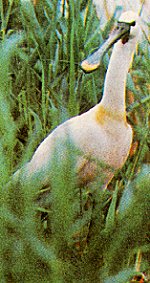 Synonyms: None
Synonyms: NonePlatalea leucorodia Linnaeus, 1758
 Synonyms: None
Synonyms: None
Common names: Bulg: Lopatar; Engl: Spoonbill; Rom: Lopatar; Russ: Kolpitza; Turk: Kasikci; Ukr: Kolpytza, Kosar'
Order: CICONIIFORMES
Family: THESKIORNITHIDAE
Taxonomic descriptions: Around 200-250 pairs.
IUCN Status:
World level: EN
Black Sea Regional level: EN
Subregion level: EN
 Distribution:
Distribution:
Habitats type, Critical habitats, Limiting factors: Breeds in the dense reed-beds of brackish and freshwater bays and marshy downstream riverine areas. Colonies are usually well hidden far from the shore. Feeding habitats within a 100 kilometres' zone are visited irregularly. the major ones include open and semi-open shallow waters, irrigation canala and rice-fields. Major limiting factors are water pollution, degrading of the reed-beds and the feeding capacity of the shallow riverine bays and coastal areas.
Biology: Breeding, migratory species. Arrives in March, in some years at the beginning of April. The beginning of egg-laying depends upon weather conditions and varies from 10.04 to 15.05. Full hatching at the end of May or early June. There are no monospecific colonies in the south of Ukraine, whereas those mixed with other herons are common. Nests are located on the broken reeds near small straits or open water, 0.6-0.8 m above its level either in the centre or on the periphery of the colony. The clutch size is 3 (2-5) eggs. Fledging at the age of 50-55 days. Both adults and juveniles stay in the breeding areas till departure to the breeding grounds. Its diet chiefly consists of terrestial and aquatic insects and their larvae, molluscs and small fish.
Population trends: Numbers fluctuate over the years. The oldest colonies in the Danube Delta decline, whereas growing new ones appear in the Sivash area. There is no colony capable of ensuring a stabile population. In general, numbers are critically low. Two main colonies account for 90% of the entire population.
Threats: Water pollution of the shallow bays with reed-beds and downstream riverine areas, decrease in the food resources, direct human disturbance.
Conservation measures taken: One colony is located in a reserve.
Conservation measures proposed: Obligatory protection of all breeding colonies.
References:
Compiled by: V.Siokhin